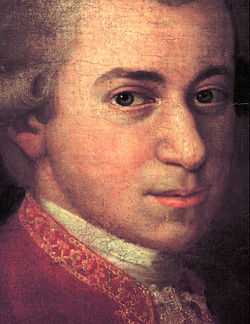Symphony No. 31 (Mozart)
The Symphony No. 31 in D major, K. 297/300a, better known as the Paris Symphony, is one of the more famous symphonies by Wolfgang Amadeus Mozart.
Composition and premiere
The work was composed in 1778 during Mozart's unsuccessful job-hunting sojourn in Paris. The composer was then 22 years old. The premiere took place on 12 June 1778 in a private performance in the home of Count Karl Heinrich Joseph von Sickingen, the ambassador of the Electorate of the Palatinate. The public premiere took place six days later in a performance by the Concert Spirituel.[1]
The work received a positive review in the June 26th issue of the Courrier de l'Europe, published in London:
- The Concert Spirituel on Corpus Christi Day began with a symphony by M. Mozart. This artist, who from the tenderest age made a name for himself among harpsichord players, may today be ranked among the most able composers.[2]
The Concert Spirituel performed the work again on the 15th of August, this time with a new second movement, an Andante replacing the original Andantino in 6/8 (the latter, according to Deutsch, "had failed to please".)[3]
The work evidently was popular. Deutsch lists several further performances by the Concert Spirituel during 1779, on 18 and 23 March, 23 May, and 3 June; and on 14 May 1780.[4] The work was published in Paris by Sieber and announced for sale 20 February 1779. During the years 1782 to 1788, Sieber's catalog described it as "in the repertoire of the Concert Spiritual".[5]
The symphony was later performed in the Burgtheater in Vienna on 11 March 1783 during a benefit concert for Mozart's sister-in-law, the singer Aloysia Weber.[6]
The music
The symphony is laid out in fast-slow-fast form, omitting the Minuet normally found in classical-era symphonies:
The symphony is notable at the time for its unusually large instrumentation, scored for a large orchestra that was available to Mozart during his time in Paris: 2 flutes, 2 oboes, 2 clarinets in A, 2 bassoons, 2 horns, 2 trumpets, timpani, and strings. It was Mozart's first symphony to use clarinets.
The first movement opens with a rising and accelerating D major scale in an effect known at the time as the Mannheim Rocket. Both second movements still exist.
Notes
References
- Deutsch, Otto Erich (1965) Mozart: A Documentary Biography. Stanford: Stanford University Press.
External links
- Sinfonie in D KV 297 (300a): Score and critical report (German) in the Neue Mozart-Ausgabe
- Symphony No. 31: Scores at the International Music Score Library Project
- Noguchi, Hideo (1998). "The Autograph Manuscripts and Early Performances of Mozart's "Paris" Symphony, K. 297 (300a)". Mozart Studies Online.
- Smith, Gary (2007). "K297/300a Symphony in D "Paris",". Mozartforum.com. Archived from the original on 29 September 2007.
| ||||||||||||||||||||
| ||||||||||||||||||
